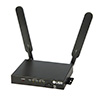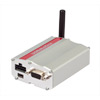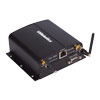Landlines Disappearing, Analog Costs Increasing!
Cellular Wireless Alternative for Dial-up Modem Connections
Muchos clientes M2M están pensando en pasarse de la tecnología analógica a la tecnología móvil, pero no saben muy bien qué conlleva esta transición. Compare el proceso y los requisitos que se muestran a continuación para comprobar si el salto a la tecnología móvil es adecuado para su negocio o sus clientes.
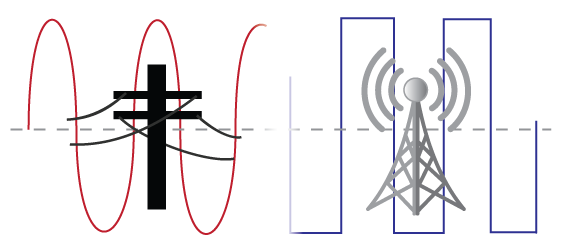
Advantages of Cellular compared to Analog
- Mobility: A landline subscription is associated with the location where the service is delivered, whereas a cellular subscription is associated with the cellular device, not the location. With the freedom of mobility, companies can move devices as needed or redeploy easily without the need to set up new subscriptions. For MSPs this cellular service can now be managed internally and resold to generate a new recurring revenue stream.
- Data Plans: Billing for a dial-up landline is based on the online time and long-distance charges, regardless of the amount of data transferred. Billing for cellular service is based the amount of data transferred, regardless of the distance or online time. So for most M2M applications, cellular service costs are significantly lower than dial-up landline service costs.
- Cost Savings over Leased Lines: Billing for a leased landline is a fixed recurring cost based on the distance, regardless of online time or the amount of data transferred. Billing for cellular service is based the amount of data transferred, regardless of the distance or online time. So for most M2M applications, cellular service costs are significantly lower than leased landline service costs.
- Availability: The availability of landline service for new installations is very poor and decreasing. The availability of cellular service is very good worldwide and continues to expand.
- Maintenance: The maintenance and repair of landlines is very poor and decreasing. The maintenance of cellular service is very good and continues to get better.
Misconceptions About Cellular Networks
Before jumping straight into how to replace dial-up modems, we first need to dispel some common myths about using cellular services and cellular modems/gateways when replacing analog modems.
Myth #1 – Cellular Modems Can Talk to Analog Modems
You might think “I can replace one analog modem with a cellular modem, and then I can use the cellular modem to connect with an analog modem”. It is easy to believe this knowing that cell phones continue to communicate with landlines with no issues. Unfortunately, that is not the case for data connections.
FACT: The landline telephone network of the 20th century carries the voice signals between two telephones or carries the data signals between two analog modems.
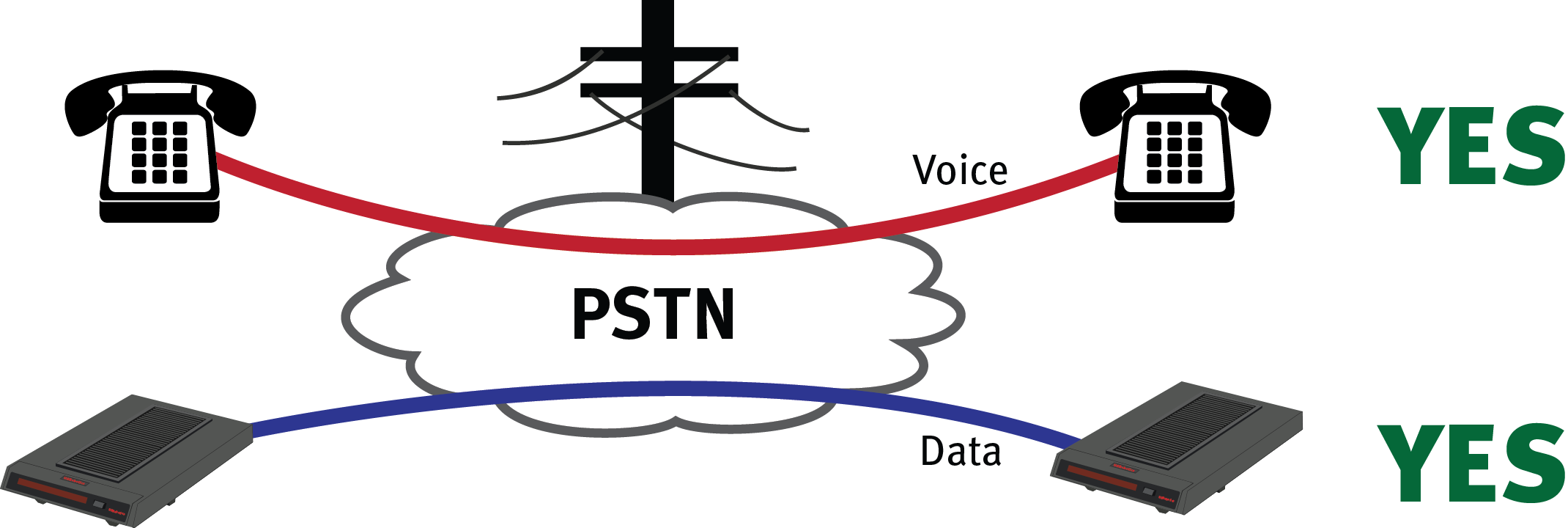
FACT: The cellular voice network of the 21st century carries voice signals between telephones and cell phones.
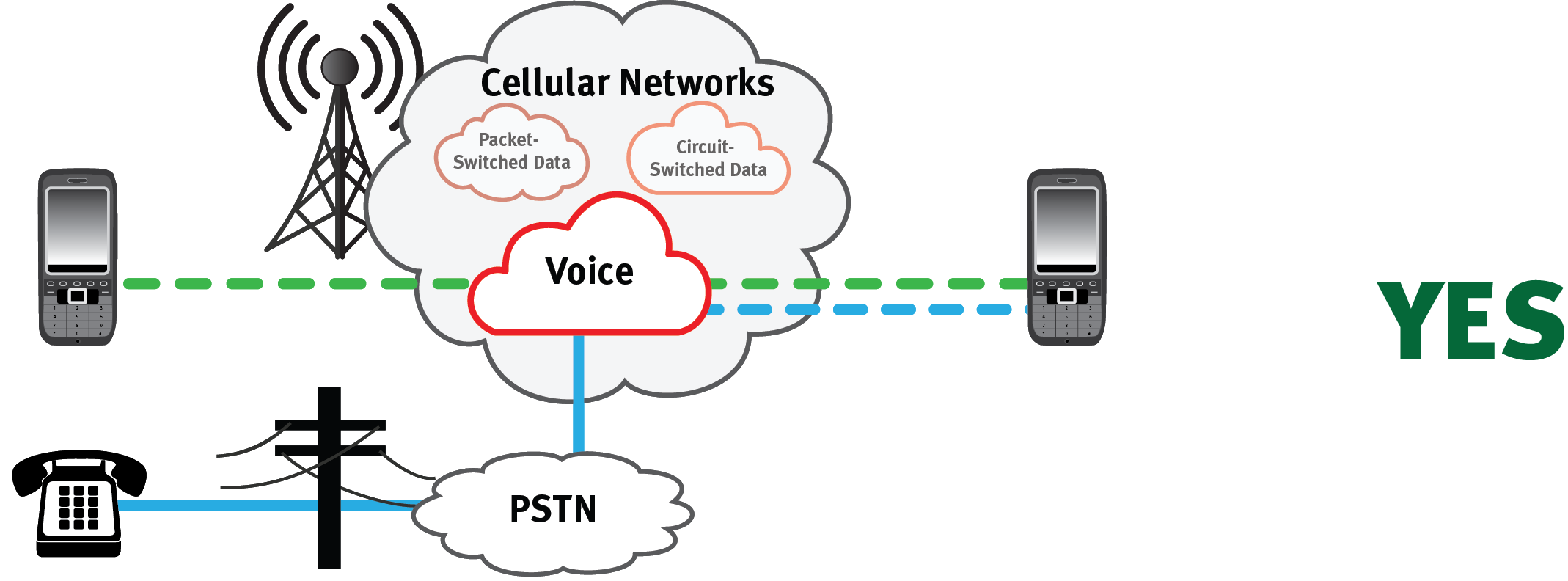
MYTH: The cellular network of the 21st century that carries voice signals between two phones could also carry the data signal of an analog modem to a cellular modem.
FACT: Cellular modems use a separate cellular data network that does not have access to the PSTN.
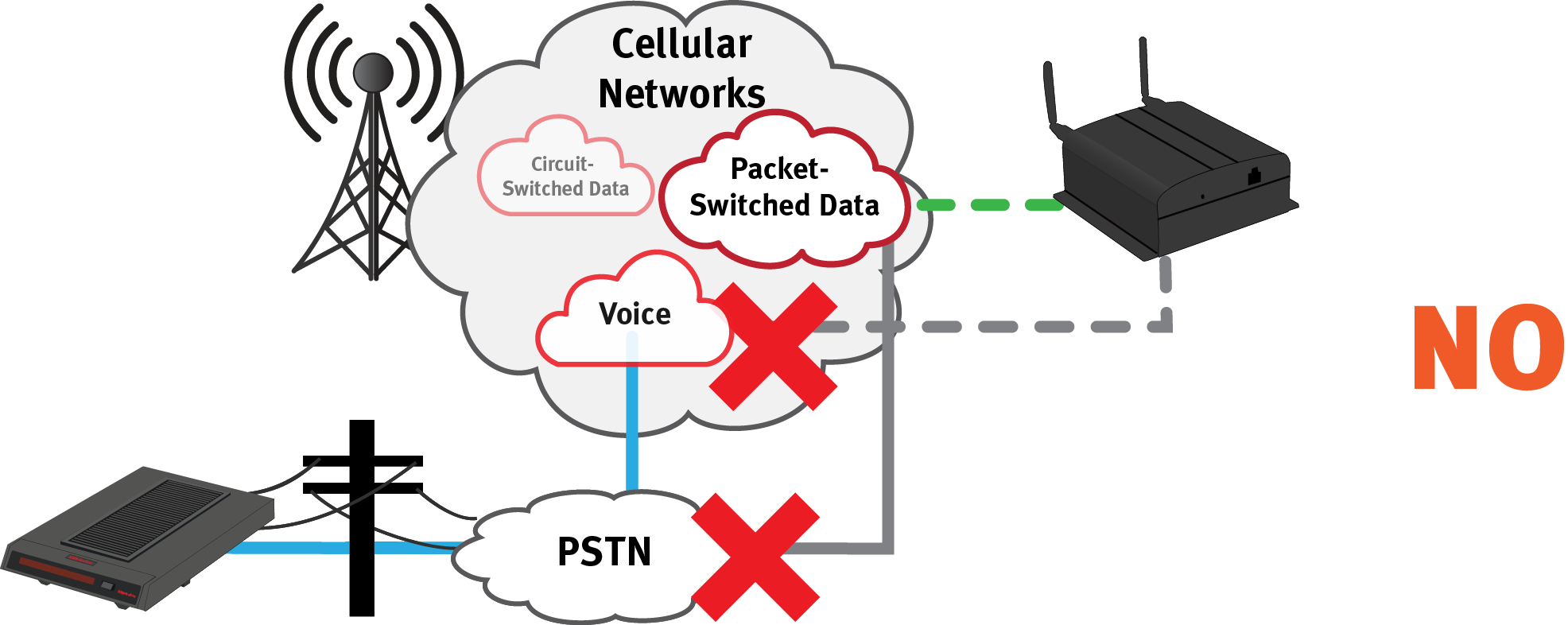
The type of cellular-to-analog modem connection shown above is not possible because:
The cellular network’s voice service, while adequate for voice communications, is too low-fidelity to carry the signals of an analog modem.
Cellular modems and gateways use cellular data service, but no connection exists between the cellular data network and the PSTN.
Analog and Cellular hardware do not support the same transmission protocols
- Cellular modems and gateways do not support the analog modem protocols (e.g. V.34, V.32, V.22bis, etc.) that are needed to connect with an analog modem.
- Analog modems do not support the IP protocols (e.g. TCP, UDP) that would be needed to connect over a data network to a cellular modem or gateway.
Myth #2 – Cellular Devices Operate Peer-to-Peer
Another common misconception is that you can replace two analog modems with two cellular modems so that one cellular modem can connect to the other cellular modem.
FACT: Analog modems can make peer-to-peer connections to other analog modems over the PSTN, and either modem can originate or answer the connection.

FACT: Cellular phones can make peer-to-peer connections to other cellular phones over the cellular voice network, and either phone can originate or answer the connection.

MYTH: Cellular modems can operate peer-to-peer like analog modems or cellular phones, and originate or answer connections over cellular networks.

FACT: The type of device-to-device connection over a cellular data network shown above is usually not possible because cellular service providers normally do not allow cellular data devices to directly contact other cellular data devices. Conventional cellular data service only allows cellular data devices to contact IP addresses on the Internet, not device IP addresses on the cellular networks. One possible workaround is to find a cellular service provider that offers peer-to-peer data connectivity.

FACT: The type of device-to-device connection over cellular data networks via the Internet shown above is usually not possible and is risky because:
- Cellular service providers normally provision cellular modems and gateways with dynamic IP addresses. Since dynamic IP addresses change periodically, the cellular modem or gateway that initiates a connection won’t know the current IP address of the destination cellular modem or gateway. Two possible workarounds are:
- Some cellular service providers can provision static IP addresses.
- Some cellular modems or gateways can work with a dynamic DNS service to allow URL addressing.
- Public IP addresses (whether static or dynamic) are vulnerable to Denial-of-Service attack from the Internet. A DoS attack can cause very high charges on a cellular data plan, since cellular data services are billed based on the amount of data sent or received.
- Cellular service providers may utilize a firewall in their network that prevents incoming connections from the Internet (including DoS attacks). These cellular service providers may offer VPN connectivity into their network, but the originating cellular modem or gateway must support the protocols necessary to connect to the VPN.
Cellular Solutions
So if cellular modems can’t communicate with dial-up modems, and if cellular data networks don’t normally allow peer-to-peer connections, what are the options for legacy analog M2M system replacements?
Cellular Client/Server
In the following scenarios a legacy peer-to-peer analog M2M system is transformed into a client/server M2M system by replacing the host modem and the host application software with an IP client or server that has access to the Internet.
Host Server, Mobile-Originated Connections
One approach to achieve these mobile-originated connections uses a host server that is publicly routable with a static IP address or URL. Alternatively, if the security risks of a publicly routable host are unacceptable, the host server can reside behind a firewall, providing that the cellular modem or gateway supports the VPN protocols necessary to tunnel through the firewall to the host.
- IP-to-IP: Most newer M2M systems that use only mobile-originated connections to a host server should be able to utilize cellular connections (data packets via IP) in a client/server environment. If this is the case, most cellular modems and gateways can be used with minimal configuration, and suitable cellular data services are widely available.
- Analog-to-IP: Legacy analog M2M systems that use only mobile-originated connections are relatively easy to convert to cellular, and use cellular data services that are widely available.
- Middleware solutions exist that can emulate a COM port and translate dial commands into IP addressing and translate serial data into packets, so that a legacy system can continue to use legacy applications at the originating end with a basic cellular gateway. However, the legacy system must allow installation of the new middleware, and the middleware must support the legacy operating system.
- Hardware solutions exist that can take data sent from an analog modem and convert it to data packets that can be sent over cellular networks, so that a legacy system can continue to use an analog modem and legacy applications at the originating end. Note that this type of device incorporates complex and costly hardware to provide PSTN emulation and analog signal demodulation, along with cellular data transmission.
- Host-initiated IP-to-IP: If the M2M host can send an SMS message and if the cellular modem or gateway can receive the SMS message and respond by initiating a connection to the host, conventional cellular services can be used to contact the M2M host. However, the M2M system must be tolerant of delayed or lost SMS messages.

Host Client, Mobile-Terminated Connections
In this case remote dial-up modems with a serial interface are replaced with cellular modems or gateways that have a serial interface and persistent cellular connectivity. Several techniques make mobile-terminated client/server cellular connections to the serial interface possible.
- Public static IP addressing: If the cellular service provider offers public static IP addressing, cellular modems and gateways that implement persistent connectivity can be used to accept IP sessions from an M2M host. However, public IP addresses are vulnerable to attack from the Internet.
- Public dynamic IP addressing: If the cellular service provider offers public dynamic IP addressing, cellular modems and gateways that implement persistent connectivity and support dynamic DNS can be used to accept IP sessions from an M2M host via a public DSN service.
However, public IP addresses are vulnerable to attack from the Internet.
- Private static IP addressing: If the cellular service provider offers private static IP addressing and a VPN tunnel into their network, cellular modems and gateways that implement persistent connectivity can be used to accept IP sessions from an M2M host through the VPN tunnel.
Cellular Peer-to-Peer
In some cases a legacy peer-to-peer M2M system will be too difficult to convert into a client/server system. In the following scenarios the cellular service provider must provision service that provides device-to-device data routing and static IP addressing. With this type of peer-to-peer service, the cellular modems or gateways may originate or answer a connection, and they connect together on a private network without traversing the Internet. This type of private network connection is inherently secure because the data is shielded from Internet snooping, and the devices are protected from Internet attacks.
- IP-to-IP: In this case the analog modems on both ends of the connection are replaced with cellular modems or gateways, and on both ends of the connection the legacy software applications that dial PSTN phone numbers and answer incoming PSTN calls are reconfigured or replaced to allow connecting over IP as a server or client.

Choosing Hardware for your Solution
It might be hard comparing cellular devices with the variety of products available in the marketplace. There may be specific needs for your unique solution, so look for some of the following features or associated applications:
- GPS for Asset Management or Fleet Tracking
- Persistent Connectivity for Remote Maintenance & Control
- Intelligent Terminal for Environmental Monitoring and Security Systems
- Modem Speed (2G/3G/4G) for Failover & Out of Band Management
- Peer-to-Peer Connectivity for Legacy analog systems
- Hardware Interface options (serial, Ethernet)
USR offers a variety of cellular products with features that are designed with M2M systems in mind. See example solutions and applications below to see which product will fit your solution best.
- Native RS-232/RS-485 Serial and 10/100 RJ45 Ethernet interfaces
- Use the USR3513 on all major 4G networks utilizing the embedded dual radios for multiple carriers in North America, and if the SIM allows fallback to 3G (North America) or 2G (Europe)
- Extend current 2G/3G deployment lifespans by installing 4G Cat 1 for comparable data requirements and lower hardware costs than Cat 4
- Use with conventional cellular data service for mobile-originated connection from serial or Ethernet equipment to the Internet
- Use with VPN cellular data service and private static IP addressing for mobile-terminated connection from an IP Telnet terminal or host to serial or Ethernet equipment, and for mobile-originated connection from serial or Ethernet equipment to the Internet
- IPSec VPN client or OpenVPN client for secure mobile-originated connection to a private host
- Versatile Firewall for preventing unauthorized mobile-terminated connections
- Remote configuration
- Use with conventional cellular data service for mobile-originated connection from serial equipment to the Internet
- Use with VPN cellular data service and private static IP addressing for mobile-terminated connection from an IP Telnet terminal or host to serial equipment, and for mobile-originated connection from serial equipment to the Internet
- The compact size of this cellular modem, GPS capability, and the available accessory kit make this modem ideal for transportation, fleet management, remote off-site installations, or self-supported hardware installations
- Use USR3510 with its dual cellular radios (GSM, CDMA) and regulatory and cellular approvals for North American installations where carrier types may vary. One device that can be used for multiple carriers with no hardware changes.
- Use USR803510 with its GSM-only cellular radio and regulatory approvals for European installations.
- Use with conventional cellular data service for mobile-originated connection from serial or Ethernet equipment to the Internet
- Use with VPN cellular data service and private static IP addressing for mobile-terminated connection from an IP Telnet terminal or host to serial or Ethernet equipment, and for mobile-originated connection from serial or Ethernet equipment to the Internet
- IPSec VPN client for secure mobile-originated connection to a private host
- Versatile Firewall for preventing unauthorized mobile-terminated connections
- GPS location tracking
- Over-the-air firmware updates or configuration
Next Steps
After reviewing your legacy analog M2M system you should be able to answer these high level questions:
- Can your system support IP data?
- Will you need server Host or client Host?
- Will you need mobile-originated or mobile-terminated connections?
- Will you still need peer-to-peer connections?
- Can you transition your whole application to cellular at one time?
- Would it be beneficial to have both cellular and dial-up connections in your solution?
When you are ready, determine which solution best fits your application. If you just don’t have the time or expertise and require some insight — USR is here to help. We have sales engineers on hand to help you analyze your application and help determine the right solution.
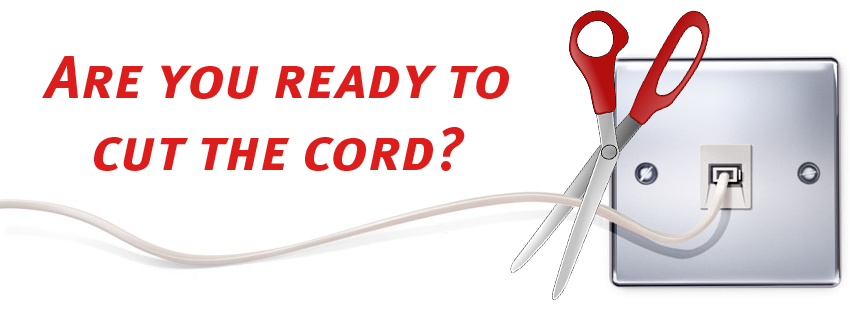
Contact USR
Explore USR Cellular Products
View More M2M Applications
|










